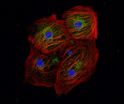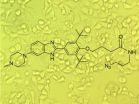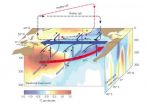(Press-News.org) SAN FRANCISCO, CA—February 9, 2014—Sometimes biology is cruel. Sometimes simply a one-letter change in the human genetic code is the difference between health and a deadly disease. But even though doctors and scientists have long studied disorders caused by these tiny changes, replicating them to study in human stem cells has proven challenging. But now, scientists at the Gladstone Institutes have found a way to efficiently edit the human genome one letter at a time—not only boosting researchers' ability to model human disease, but also paving the way for therapies that cure disease by fixing these so-called 'bugs' in a patient's genetic code.
Led by Gladstone Investigator Bruce Conklin, MD, the research team describes in the latest issue of Nature Methods how they have solved one of science and medicine's most pressing problems: how to efficiently and accurately capture rare genetic mutations that cause disease—as well as how to fix them. This pioneering technique highlights the type of out-of-the-box thinking that is often critical for scientific success.
"Advances in human genetics have led to the discovery of hundreds of genetic changes linked to disease, but until now we've lacked an efficient means of studying them," explained Dr. Conklin. "To meet this challenge, we must have the capability to engineer the human genome, one letter at a time, with tools that are efficient, robust and accurate. And the method that we outline in our study does just that."
One of the major challenges preventing researchers from efficiently generating and studying these genetic diseases is that they can exist at frequencies as low as 1%, making the task of finding and studying them labor-intensive.
"For our method to work, we needed to find a way to efficiently identify a single mutation among hundreds of normal, healthy cells," explained Gladstone Research Scientist Yuichiro Miyaoka, PhD, the paper's lead author. "So we designed a special fluorescent probe that would distinguish the mutated sequence from the original sequences. We were then able to sort through both sets of sequences and detect mutant cells—even when they made up as little one in every thousand cells. This is a level of sensitivity more than one hundred times greater than traditional methods."
The team then applied these new methods to induced pluripotent stem cells, or iPS cells. These cells, derived from the skin cells of human patients, have the same genetic makeup—including any potential disease-causing mutations—as the patient. In this case, the research team first used a highly advanced gene-editing technique called TALENs to introduce a specific mutation into the genome. Some gene-editing techniques, while effective at modifying the genetic code, involve the use of genetic markers that then leave a 'scar' on the newly edited genome. These scars can then affect subsequent generations of cells, complicating future analysis. Athough TALENs, and other similarly advanced tools, are able to make a clean, scarless single letter edits, these edits are very rare, so that new technique from the Conklin lab is needed.
"Our method provides a novel way to capture and amplify specific mutations that are normally exceedingly rare," said Dr. Conklin. "Our high-efficiency, high-fidelity method could very well be the basis for the next phase of human genetics research."
"Now that powerful gene-editing tools, such as TALENs, are readily available, the next step is to streamline their implementation into stem cell research," said Dirk Hockemeyer, PhD, assistant professor of molecular and cellular biology at the University of California, Berkeley, who was not involved in this study. "This process will be greatly facilitated by the method described by Dr. Conklin and colleagues."
"Some of the most devastating diseases we face are caused by the tiniest of genetic changes," added Dr. Conklin. "But we are hopeful that our technique, by treating the human genome like lines of computer code, could one day be used to reverse these harmful mutations, and essentially repair the damaged code."
INFORMATION:
Other Gladstone scientists who contributed to this research are: Amanda Chan, Luke Judge, MD, PhD, Jennie Yoo, Trieu Nguyen, Paweena Lizarraga and Po-Lin So, PhD. Many organizations provided support for this research, including the Japan Society for the Promotion of Science, the Uehara Memorial Foundation, the California Institute for Regenerative Medicine, the National Heart, Lung, and Blood Institute, the Roddenberry Foundation and the National Institutes of Health.
About the Gladstone Institutes
Gladstone is an independent and nonprofit biomedical-research organization dedicated to accelerating the pace of scientific discovery and innovation to prevent, treat and cure cardiovascular, viral and neurological diseases. Gladstone is affiliated with the University of California, San Francisco.
Genome editing goes hi-fi
Gladstone's innovative technique in stem cells to boost scientists' ability to study -- and potentially cure -- genetic disease
2014-02-10
ELSE PRESS RELEASES FROM THIS DATE:
Cochlear implants -- with no exterior hardware
2014-02-10
Cochlear implants — medical devices that electrically stimulate the auditory nerve — have granted at least limited hearing to hundreds of thousands of people worldwide who otherwise would be totally deaf. Existing versions of the device, however, require that a disk-shaped transmitter about an inch in diameter be affixed to the skull, with a wire snaking down to a joint microphone and power source that looks like an oversized hearing aid around the patient's ear.
Researchers at MIT's Microsystems Technology Laboratory (MTL), together with physicians from Harvard Medical ...
Scientists invent advanced approach to identify new drug candidates from genome sequence
2014-02-10
JUPITER, FL—February 9, 2014—In research that could ultimately lead to many new medicines, scientists from the Florida campus of The Scripps Research Institute (TSRI) have developed a potentially general approach to design drugs from genome sequence. As a proof of principle, they identified a highly potent compound that causes cancer cells to attack themselves and die.
"This is the first time therapeutic small molecules have been rationally designed from only an RNA sequence—something many doubted could be done," said Matthew Disney, PhD, an associate professor at TSRI ...
Fight or flight? Vocal cues help deer decide during mating season
2014-02-10
Previous studies have shown that male fallow deer, known as bucks, can call for a mate more than 3000 times per hour during the rut (peak of the mating season), and their efforts in calling, fighting and mating can leave them sounding hoarse.
In this new study, published today (10 February) in the journal Behavioral Ecology, scientists were able to gauge that fallow bucks listen to the sound quality of rival males' calls and evaluate how exhausted the caller is and whether they should fight or keep their distance.
"Fallow bucks are among the most impressive vocal athletes ...
Pacific trade winds stall global surface warming -- for now
2014-02-10
Heat stored in the western Pacific Ocean caused by an unprecedented strengthening of the equatorial trade winds appears to be largely responsible for the hiatus in surface warming observed over the past 13 years.
New research published today in the journal Nature Climate Change indicates that the dramatic acceleration in winds has invigorated the circulation of the Pacific Ocean, causing more heat to be taken out of the atmosphere and transferred into the subsurface ocean, while bringing cooler waters to the surface.
"Scientists have long suspected that extra ocean ...
Seven new genetic regions linked to type 2 diabetes
2014-02-10
Seven new genetic regions associated with type 2 diabetes have been identified in the largest study to date of the genetic basis of the disease.
DNA data was brought together from more than 48,000 patients and 139,000 healthy controls from four different ethnic groups. The research was conducted by an international consortium of investigators from 20 countries on four continents, co-led by investigators from Oxford University's Wellcome Trust Centre for Human Genetics.
The majority of such 'genome-wide association studies' have been done in populations with European ...
Optogenetic toolkit goes multicolor
2014-02-10
CAMBRIDGE, MA -- Optogenetics is a technique that allows scientists to control neurons' electrical activity with light by engineering them to express light-sensitive proteins. Within the past decade, it has become a very powerful tool for discovering the functions of different types of cells in the brain.
Most of these light-sensitive proteins, known as opsins, respond to light in the blue-green range. Now, a team led by MIT has discovered an opsin that is sensitive to red light, which allows researchers to independently control the activity of two populations of neurons ...
Clues to cancer pathogenesis found in cell-conditioned media
2014-02-10
Philadelphia, PA, February 10, 2014 – Primary effusion lymphoma (PEL) is a rare B-cell neoplasm distinguished by its tendency to spread along the thin serous membranes that line body cavities without infiltrating or destroying nearby tissue. By growing PEL cells in culture and analyzing the secretome (proteins secreted into cell-conditioned media), investigators have identified proteins that may explain PEL pathogenesis, its peculiar cell adhesion, and migration patterns. They also recognized related oncogenic pathways, thereby providing rationales for more individualized ...
Smoking linked with increased risk of most common type of breast cancer
2014-02-10
Young women who smoke and have been smoking a pack a day for a decade or more have a significantly increased risk of developing the most common type of breast cancer. That is the finding of an analysis published early online in Cancer, a peer-reviewed journal of the American Cancer Society. The study indicates that an increased risk of breast cancer may be another health risk incurred by young women who smoke.
The majority of recent studies evaluating the relationship between smoking and breast cancer risk among young women have found that smoking is linked with an increased ...
No strength in numbers
2014-02-10
Urban legislators have long lamented that they do not get their fair share of bills passed in state governments, often blaming rural and suburban interests for blocking their efforts. Now a new study confirms one of those suspicions but surprisingly refutes the other.
The analysis—of 1,736 bills in 13 states over 120 years—found that big-city legislation was passed at dramatically lower rates than bills for smaller places.
However, rural and suburban colleagues should not be blamed for the dismal track record, conclude co-authors Gerald Gamm of the University of Rochester ...
Virtual avatars may impact real-world behavior
2014-02-10
How you represent yourself in the virtual world of video games may affect how you behave toward others in the real world, according to new research published in Psychological Science, a journal of the Association for Psychological Science.
"Our results indicate that just five minutes of role-play in virtual environments as either a hero or villain can easily cause people to reward or punish anonymous strangers," says lead researcher Gunwoo Yoon of the University of Illinois at Urbana-Champaign.
As Yoon and co-author Patrick Vargas note, virtual environments afford people ...
LAST 30 PRESS RELEASES:
First Editorial of 2026: Resisting AI slop
Joint ground- and space-based observations reveal Saturn-mass rogue planet
Inheritable genetic variant offers protection against blood cancer risk and progression
Pigs settled Pacific islands alongside early human voyagers
A Coral reef’s daily pulse reshapes microbes in surrounding waters
EAST Tokamak experiments exceed plasma density limit, offering new approach to fusion ignition
Groundbreaking discovery reveals Africa’s oldest cremation pyre and complex ritual practices
First breathing ‘lung-on-chip’ developed using genetically identical cells
How people moved pigs across the Pacific
Interaction of climate change and human activity and its impact on plant diversity in Qinghai-Tibet plateau
From addressing uncertainty to national strategy: an interpretation of Professor Lim Siong Guan’s views
Clinical trials on AI language model use in digestive healthcare
Scientists improve robotic visual–inertial trajectory localization accuracy using cross-modal interaction and selection techniques
Correlation between cancer cachexia and immune-related adverse events in HCC
Human adipose tissue: a new source for functional organoids
Metro lines double as freight highways during off-peak hours, Beijing study shows
Biomedical functions and applications of nanomaterials in tumor diagnosis and treatment: perspectives from ophthalmic oncology
3D imaging unveils how passivation improves perovskite solar cell performance
Enriching framework Al sites in 8-membered rings of Cu-SSZ-39 zeolite to enhance low-temperature ammonia selective catalytic reduction performance
AI-powered RNA drug development: a new frontier in therapeutics
Decoupling the HOR enhancement on PtRu: Dynamically matching interfacial water to reaction coordinates
Sulfur isn’t poisonous when it synergistically acts with phosphine in olefins hydroformylation
URI researchers uncover molecular mechanisms behind speciation in corals
Chitin based carbon aerogel offers a cleaner way to store thermal energy
Tracing hidden sources of nitrate pollution in rapidly changing rural urban landscapes
Viruses on plastic pollution may quietly accelerate the spread of antibiotic resistance
Three UH Rainbow Babies & Children’s faculty elected to prestigious American Pediatric Society
Tunnel resilience models unveiled to aid post-earthquake recovery
Satellite communication systems: the future of 5G/6G connectivity
Space computing power networks: a new frontier for satellite technologies
[Press-News.org] Genome editing goes hi-fiGladstone's innovative technique in stem cells to boost scientists' ability to study -- and potentially cure -- genetic disease




